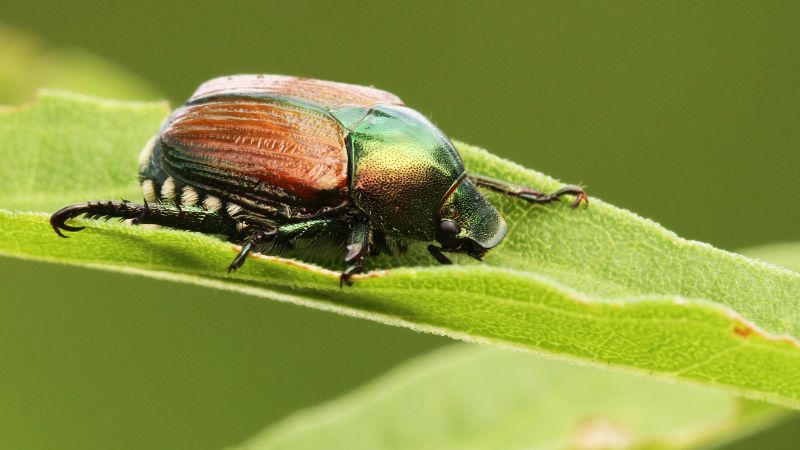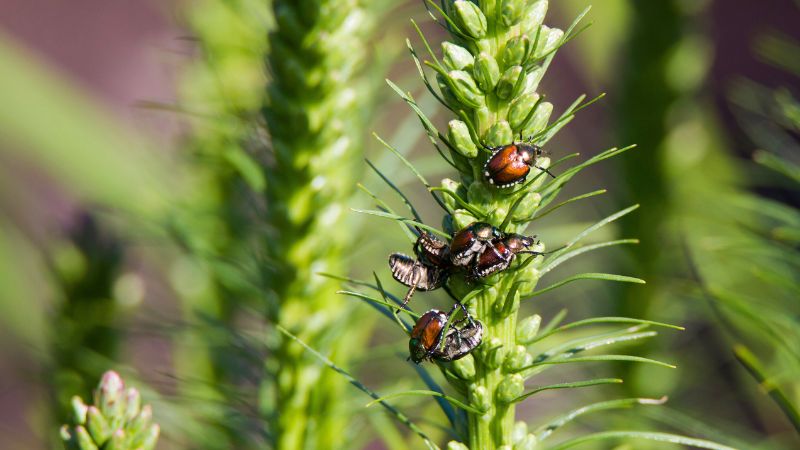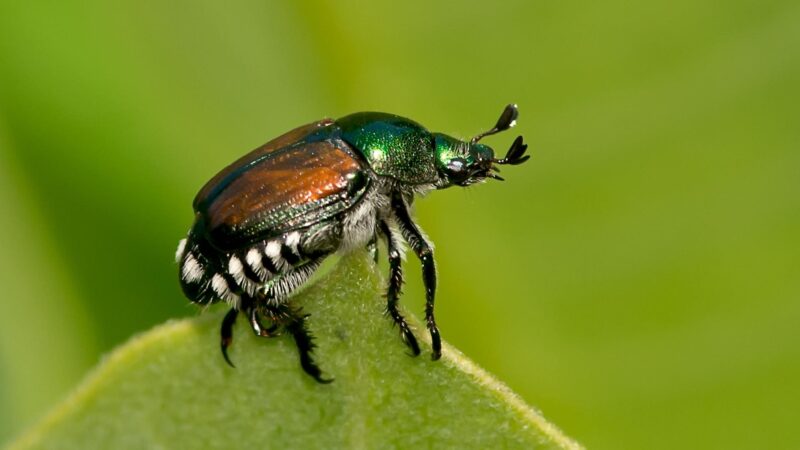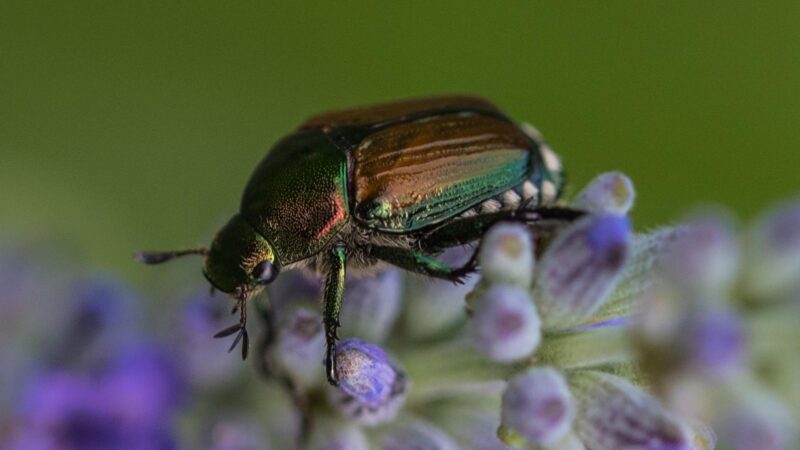Japanese beetles are destructive bugs that can cause devastating damage to the leaves of various trees, flowers, bushes, vegetables, and other plants. They feast on delicate parts of vegetation, leaving behind plants in poor condition.
So, how to get rid of Japanese beetles naturally? To get rid of Japanese beetles naturally, you can use the following:
- Neem Oil: the strong scent of this oil makes Japanese beetles think twice before invading your property.
- Diatomaceous Earth: food-grade DE is crafted from the fossilized remains of diatoms (algae) known to dry out the exoskeleton of insects that comes in contact with the powder.
There are several ways to get rid of Japanese beetles, and you will find the rest of them when you continue reading. In addition, you will know more about their characteristics and other fascinating things.
What Is a Japanese Beetle?

Japanese beetles (Popillia japonica) are destructive pests to many gardens and field crops. Adults consume various vegetation and fruits of several species, such as shrubs, crops, vines, and trees. Meanwhile, the larvae feed on the roots of grasses and other plants, often ruining turf in parks, lawns, and golf courses.
What Does a Japanese Beetle Look Like?
Japanese beetles are very easy to identify. When you see them, you will notice their copper-colored bodies and metallic green heads that are usually glowing.
The larvae, which are usually referred to as white grubs or simply grubs, own a grayish-black back and brown head. You can see the bulleted guide below to understand their differences in terms of physical attributes.
Adult Japanese Beetle Physical Features
- The adult Japanese beetle can grow around ⅓ to ½ of an inch long.
- They possess a metallic green head with copper-brown wing covers and a dark thorax.
- Their abdomen’s sides have five white hair patches, while their abdomen tips consist of two white hair patches.
The Larvae Physical Features
- The larvae or grubs possess a white to cream color and are C-shaped, with a particular tan head.
- They can grow from ⅛ of an inch to around one inch long.
What Attracts Japanese Beetles?
Japanese Beetles are not selective eaters and consume over 300 species of plants, including asparagus, hibiscus, roses, raspberries, blackberries, wisteria, and canna. They get attracted to these plant species due to the odors they induced.
Are Japanese Beetles Harmful?
Japanese beetles are deemed harmless to people and pets. Though they may chew out at flowers and plants, you will not encounter this beetle species biting your skin.
They may try to nip you with their mandibles, but they are too weak, so it’s unlikely that they can damage your skin. Their legs are also rough, making you sense something prickly when they land on your skin.
Related: Are Carpet Beetles Harmful? | Important Facts!
Are Japanese Beetles Invasive?

Yes, they are, to the extent that they go long distances as hitchhikers on plant material, such as the roots, soil, and even cars. Additionally, it eats over 300 types of plants, damages pastures and lawns, and skeletonizes leaves and other vegetation.
How to Keep Japanese Beetles Away?
To keep these beetles away from your precious plants, consider doing the following methods:
Natural Predators
Another way to deal with Japanese beetles is by attracting their natural predators, such as birds. You can either make a home for birds on your property or build a birdbath to let them flock towards your property.
The birds will then begin consuming Japanese beetles, thereby reducing their population significantly. With the presence of their natural predators, Japanese beetles will think twice before getting into your property again.
Selective Planting
If you are living in a place often invaded by Japanese beetles, avoid planting plants that Japanese beetles love, such as apples, American and English elms, birch, beans, crabapple, cherry, crape myrtle, mountain ash, linden, grapes, roses, beans, raspberries, rose of sharon, and pin oak.
Replace these plants with more resistant options, such as oaks, dogwood, boxwood, hemlock, magnolia, holly, red and silver maple, sweetgum, euonymus, common lilac, and tuliptree.
How to Kill Japanese Beetles?
Treating these beetles during their larval stage can remarkably reduce the threat of the adult beetles, laying the legwork for long-term beetle control. Grubs are efficiently treated in lawns during late summer through fall.
There are several ways to deal with Japanese beetle larvae naturally, such as:
Beneficial Nematodes
Beneficial nematodes are tiny roundworms without segments in their bodies that emerge naturally in soil. Within the nematode’s gut is a valuable bacteria that can kill insects in the span of 24 to 48 hours from the release. This approach is entirely safe for people, plants, pets, and useful insects.
- Scotts GrubEx1 Season Long Grub Killer can help prevent turf...
- One application of this lawn care treatment kills and prevents...
- This grub killer also controls caterpillars (armyworm),...
- Apply this granular insecticide to a dry lawn in the spring or...
- One 14.35 lb. bag of Scotts GrubEx1 Season Long Grub Killer...
Milky Spore
If long-term control is what you want, then you can consider using milky spore powder (Bacillus popilliae). This is another natural killer of grubs, but it takes time to see a significant result. On the good side, the milky spore’s effects can last over 15 years.
Handpick Adult Beetles
This is one of the most effective ways to manage Japanese beetles. However, this requires daily lookout, often up to several weeks, or as long as you can still see the beetles actively foraging at your premises. The best time to do handpicking is during the early morning, while they are still sedentary.
Set a drop cloth beneath the affected plants and shake to separate the beetles. Then gather the beetles and put them into a bucket filled with soapy water. After that, remove the damaged leaves and lifeless beetles to prevent attraction more like them.
Japanese Beetle Traps
This method presents varied results. Though these do an excellent job catching beetles that creep into them, the bait can lure more beetles from close areas, inducing more harm than good.
If used, put them far away from your plants. It’s also best to note that Japanese beetle traps need baits to be effective.
You can use baits with a flower or fruity scent. The aromas travel via air, and the beetles’ antenna picks the scent, luring the beetle into the trap.
You can also make your own trap by doing the following:
- Wash used any jar or container and fill it with one-third full of minimal warm water.
- Next, add a packet of yeast to the warm water and ¼ cup of sugar and mix well.
- After that, mash a soft fruit like a banana and add it to the mixture. This sweet mixture will serve as bait, attracting beetles to your trap.
- Pour a small amount of dishwashing soap into the jug. This will help eliminate the bugs when they trip into the trap.
- Finally, put the milk jar close to the affected area in your garden or yard. Set the trap in a slightly elevated position off the ground.
Don’t cover the container so that the Japanese beetles can easily find their way into the trap. Once they smell the mixture, they will crawl into it and get drawn, causing them to die eventually.
Neem Oil
Neem oil is used often as a botanical insecticide, reducing insects’ feeding. It is best to apply this item during the first sign of damage.
- 100% NATURAL NEEM OIL - Premium Nature cold pressed Neem Oil is...
- GREAT FOR DRY SKIN - Neem seed oil is great for dry skin and...
- ANTI-AGING PROPERTIES - Daily usage of bliss neem oil can help...
- MULTIPURPOSE OIL - Neem oil extract plant extract for face, skin...
- HAIR GROWTH - Neem oil for hair growth unrefined leaves cosmetic...
Just drop some neem oil into the water and add a few squeezes of mild-scented dishwashing liquid. Shake lightly to mix well, and put the mixture in a clean spray bottle. Once done, spray the solution into the affected area.
Diatomaceous Earth
Food-grade diatomaceous earth is made from the fossilized remains of diatoms (algae), which have been shown to dry out the exoskeletons of insects that come into contact with the powder.
- Natural Product 100% Chemical-Free: Made from 10lbs of food-grade...
- OMRI Listed for Organic Use: Certified by the Organic Materials...
- Diatomaceous Earth is a natural source of freshwater amorphous...
- Vegan-Keto-Gluten Free
- Trusted Brand with the highest purity standard for our...
Just sprinkle this item into the suspected areas and wait for the result. Before the application, wear gloves since this can potentially irritate your skin.
How to Make a Japanese Beetle Trap?
You can either buy a Japanese beetle trap or make one on your own. To make the beetle trap by yourself, you will need the following items:
- A utility knife
- A plastic jug, preferably gallon-sized
- A string or piece of rope or for hanging.
- ½ cup of sugar, ¼ cup water, 1 teaspoon of active dry yeast, and 1 cup of mashed ripe fruit,
- A large slotted spoon/ long-handled colander
Procedure:
- Start by thoroughly cleaning the plastic jug and carefully cutting the large opening in the top, but make sure to leave the handle untouched.
- Next, mix the sugar, yeast, mashed fruit, and water thoroughly.
- Once done, hang the trap in a tree’s limb around three feet away from the ground, or dangle it from a hook meant for a hanging flower basket.
Before long, you will detect Japanese beetles floating in the trap but can’t escape and will ultimately drown. Each day, make sure to strain out lifeless beetles and fruit cuts and replace them as required.
Properly dispose of the dead bugs and rotting fruit in an airtight bag to prevent the mix from casting an offensive odor, attracting Japanese beetles all over again.
About Japanese Beetles

As adults, Japanese beetles are capable of decimating gardens, leaving only sapped plants and their skeletonized leaves behind. During their nymph stage, they’re commonly called grubs. They binge-eat on tender grass roots, leaving only brown, dying lawns in their path.
The damage caused by the Japanese beetle is elaborated since destruction often transpires during their multiple life phases. The first signs typically appear when mature beetles arise from the soil during late spring to midsummer.
They’re often seen flying in from nearby sites and picking out stressed-out plants. They are around ½ of an inch long, with shiny, metallic green bodies, bronze wings, and white, dot-like hair tussocks in their rear and sides.
Related: Powderpost Beetle | Identification, Habitat, and Behavior
Where Do Japanese Beetles Come From?
Japanese beetles are originally from northern Japan. They were first encountered in the U.S. in New Jersey in 1916 and have ever since become established in Minnesota regions.
How Big Are Japanese Beetles?
Eggs that are newly-laid are approximately 1/20 to 1/16 inch in size. As they grow older, their size doubles, eventually reaching to their larval stage which makes them about 1 inch in length. Finally, Japanese beetle adults shrink to ½ inch.
What Color Are Japanese Beetles?
Japanese beetles have copper-colored wings, dark thorax, and metallic green heads and bodies. Both sides of their abdomen have five white hair patches and two at the tip.
Do Japanese Beetles Fly?
Yes, adult Japanese beetles are able to fly and can easily travel up to 15 miles in a single flight. They fly to forage for food and actively do so primarily between July and August.
Do Japanese Beetles Lay Eggs?
The female beetle of this species can lay up to 40 to 60 eggs in her entire life, favoring wet soil with a grassy surface. They excavate the soil multiple times for nearly two weeks, every time they lay eggs in small clusters. Their eggs usually hatch after a week or two, and the larvae will then feed on the close roots.
What Do Japanese Beetles Eat?
Japanese beetles consume leaves, flower buds, and overripe fruits and often forage in groups, beginning at the plant’s top, then downwards. They are able to consume about 300 plant species but prefer plants like apples, roses, plums, cherries, etc.
What Eats Japanese Beetles?
Many wild animal species are natural predators of Japanese beetles, such as several species of wild birds such as cardinals, robins, and catbirds. Additionally, opossums, skunks, raccoons, shrews, and moles also dine on beetle grubs but expect them to scoop up your yard in the process.
Are Japanese Beetles Blind?

No, but they do have poor eyesight despite having compound eyes. They depend primarily on their sharp sense of smell when looking for food and performing other tasks. They can also sense chemicals carried through the air at all distances—which is how they navigate and find the things they need.
List of Sources
Cloyd, R. A. (2004). Why Do Japanese Beetle Adults Feed on Certain Plant Types?
Gyeltshen, J., Hodges, A., & Bania, C. (2019). Japanese beetle.
Hahn, J., Weisenhorn, J., & Bugeja, S. (2020). Japanese beetles in yards and gardens.
Mason, S. (2015). Japanese Beetle Myth.
Potter, D. A., Potter, M. F., & Townsend, L. H. (2006). Japanese Beetles in the Urban Landscape.
University of Illinois. (n.d.). Japanese Beetle.
- Bed Bug Surge 2025: How to Detect, Prevent, and Safely Eliminate Infestations in Top U.S. Cities - June 18, 2025
- Asian Needle Ants Invade US Homes: 2025 Guide to Identification, Risks, and Effective Control - June 11, 2025
- New World Screwworm Alert: How US Livestock Owners Can Prevent Outbreaks and Protect Herds [Summer 2025 Update] - June 8, 2025



